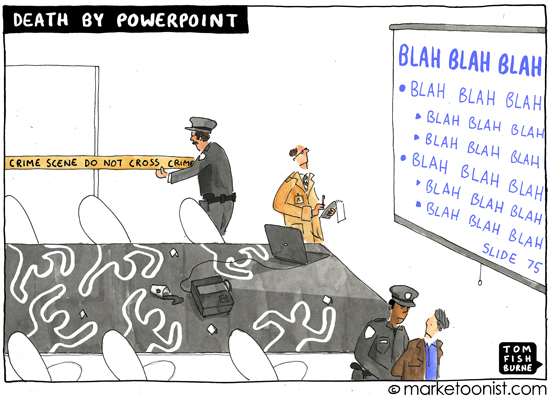Need to present a new marketing plan or program at the beginning of the year to your CMO, CEO or Board? Here are a few tips & reminders about reporting on marketing up to the C-Suite of an organization.
Present Marketing to the Boss
Based on my experiences, there are a few things to keep in mind:
- Many C-Suite executives are skeptical and uncertain about marketing spending and investments. Make sure you speak their language and understand the questions on their mind. Typically, they want to know how you justify the spending/program. In other words, how will the company see a return on invested spending?
- I always remind C-Suite executives that marketing is in the seeding business while sales are in the harvesting business. To have new customers, it takes fertilizer, water and time. Other metaphors work – but remind them that marketing isn’t like instant rice. Often C-Suite executives think that marketing should have an immediate return. It rarely happens that way. Brands take time to build and new products typically don’t take off in an instant.
- Start with a high-level summary statement like there are five key things I’m going to share with you in my 15 minutes today. It is like giving away the ending in the beginning of a movie. By doing this, you have told them the key takeaways. So if you are presenting your plans for Q1, this summary could be:
- We have a world-class PR firm supporting us as we announce our new product launch
- We have completed all the collateral revisions to support the sales team so we are prepared
- The website is updated and ready to launch on January 15th, our go-live date
- We have begun a search to fill job for our team
- We are starting a new email campaign on Feb 1st to make our current customers aware of the new product.
- Share Why The Plan May Fail – Although counterintuitive, if you raise the issues of what might go wrong or not work, it builds confidence that you aren’t naive and recognize the risks. It also neutralizes a naysayer from being critical. Get the risk out on the table quickly. By being truthful and frank about the likelihood of success, you will find your audience believing that you can achieve your plans. Sounds odd, but it is often the case that senior executives don’t want bravado – they want to understand the risk.
- Keep your commentary short and to the point. Be careful not to go on and on and on. (I’m guilty of this and have to fight the urge). By saying less, people respect the presentation more. It is counterintuitive. They can always ask clarifying questions.
- Keep your slides free of a lot of copy, so people don’t read the slides.– Show pictures and just talk to the slide but don’t speak too long about each slide. Don’t spend more than 1 minute on each slide. So if you have 15 minutes, consider ten slides so you have time for the interruptions that may come up. I prefer to limit my slide to 5 words and a sensational image that serves as a backdrop for the key message I want to cover.
- In the end, remind them of the summary again.
- It helps to show your excitement and enthusiasm – but most of the people you are presenting to want the facts and key points.
- I don’t like to give out slides printed to attendees since they won’t listen but will read. You want people to pay attention.
- I like having props to demonstrate and illustrate key points. (I will hand out packets of seeds, for example). But they can distract people. Know your audience; maybe if you hand out a new brochure, they’ll get distracted leafing through it. Consider handing materials out at the end, not at the beginning of the presentation.
PowerPoint is often a crutch. Make sure you can cover the materials if the projector doesn’t work. There is always a technical glitch. Ask yourself beforehand, what will I do if the projector doesn’t work? Like a boy scout, be prepared.
Assume that this group will remember just one message – not 15 pages of messages. Think long and carefully about what you want them to remember. Then repeat it at least three times during your presentation.
Remember, death by PowerPoint is a crime in 32 states.
Need help becoming a better presenter? Want to stand out from the crowd? I can help coach you to improve how you sell your marketing ideas. Text or call me at 919 720 0995.
Photo credit: Tom Fishburne. The Marketoonist. Sign up for Tom’s marketing cartoons here.

One of these things is different.




